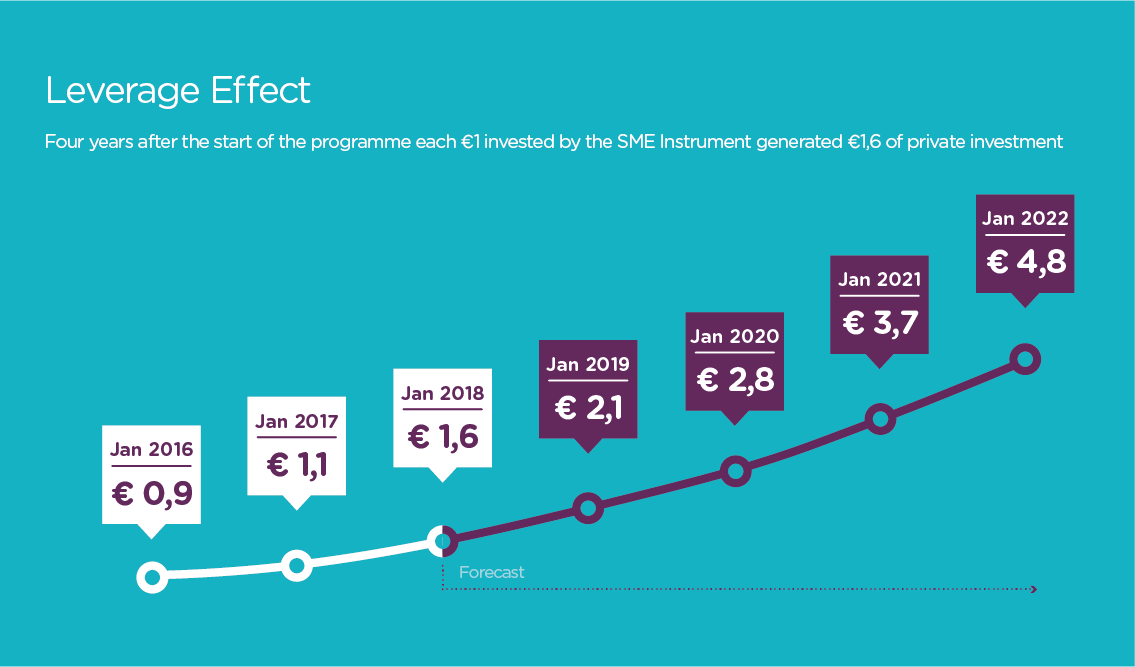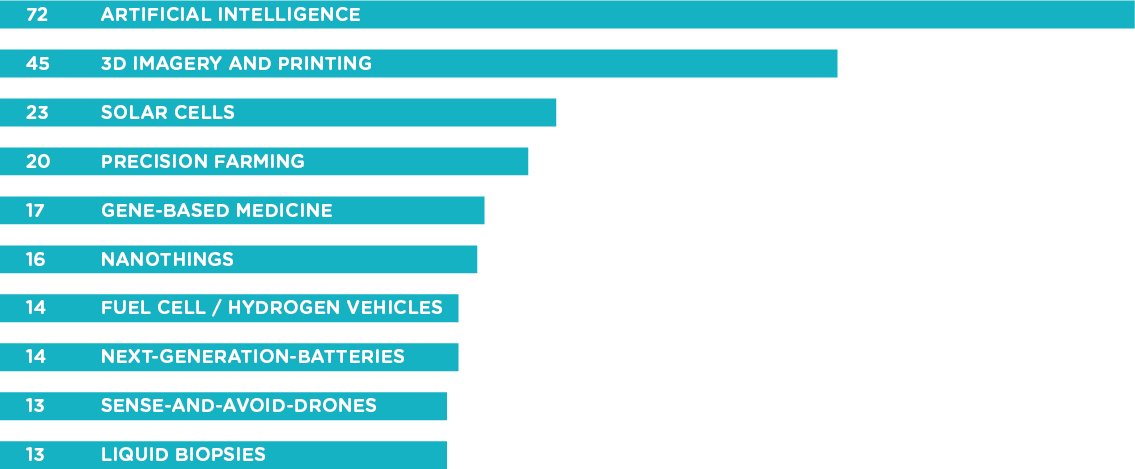Features
How significant are SMEs to the EU?
16 October 2018
Catherine Eginard, Head of Sector, H2020 – SME Instrument, talks to 4iP Council about the main highlights of the newly published SME instrument impact report. €1.5 billion is available to single applicant innovative SMEs from 2018 and 2020 through the European Commission’s SME Instrument
Horizon 2020 is the biggest EU Research and Innovation programme ever with nearly €80 billion of funding available over seven years (2014 to 2020). It aims to ensure Europe produces world-class science, removes barriers to innovation and makes it easier for the public and private sectors to work together in delivering innovation.

Here, 4iP Council speaks to Catherine Eginard, Head of Sector for Horizon 2020’s SME Instrument, about the importance of small and medium sized enterprises (SMEs) in the EU, the impact of the programme to date, the role of IP in SME grant decisions and H2020’s future after 2020.
How significant are SMEs to the EU?
SMEs are the backbone of Europe's economy. They represent 99% of all businesses in the EU. In the past five years, they have created around 85% of new jobs and provided two-thirds of the total private sector employment in the EU. The European Commission considers SMEs and entrepreneurship as key to ensuring economic growth, innovation, job creation, and social integration.
Most European Commission funding programmes, including COSME, are consortium oriented where SMEs are strongly invited to contribute but the SME Instrument is the only one dedicated to SMEs and across any sector of the economy.
Has the European Commission’s focus on supporting SMEs become more intense over recent years or are there specific EC investment trends you could comment on?
SMEs have become part of all European Commission programmes. In the future, after 2020, there will be more focus around the European Innovation Council (EIC) which will expand to cover a range of support types for SMEs including direct grants for scale up, and various financial instruments such as equity funding, direct loans reimbursable advances, exposure to investors and so on.
On 7 June 2018 the Commission adopted the ambitious proposal for Horizon Europe – the Framework Programme for Research and Innovation under the next long-term EU budget 2021-2027. Building on the achievements and success of Horizon 2020, the Commission has proposed €100 billion to keep the EU at the forefront of global research and innovation.
In this context, the Commission has proposed to earmark €10 billion to scaling up breakthrough and market-creating innovation through the new European Innovation Council. The EIC will provide direct tailor-made support to innovators through two main funding instruments – the Pathfinder and the Accelerator – which will both focus through a mainly bottom-up, high-risk approach on breakthrough innovation; on innovator needs and be proactively managed to support high risk innovation including SME scale up. Under the EU Innovation Council sums will be divided between grants and other forms of support. The Commission’s proposal is under discussion at the European Parliament and Council.
Within H2020, what are the main EU funding and support mechanisms available to SMEs?
Today, the easiest and fastest way for an innovative and high potential SME with an innovative project with the capacity to scale up to access EU funds is the SME Instrument. From the point of application it takes just five weeks for an SME to know if it has been selected for a Phase I grant (€50.000) And for a Phase II grant (which can be as much as €2.5 million) remotely evaluating a proposal, conducting interviews and informing the SME of a grant award take eight weeks.
The SME Instrument has been developed to be fully answer the needs of SMEs and has streamlined a strong process to assess around 15,000 proposals annually.
How many SMEs have received grants from the SME Instrument to date?
So far, 2300 SMEs have received Phase I grants and 900 have received Phase II grants, coming from 37 countries. Our data shows that over 70% of the Phase II companies, after having finalised their two years grant, have achieved commercial success or are well on their way to it.
In 2017, SME Instrument-funded companies accounted for 10% of all tech IPOs in Europe and the follow-up equity investments into companies funded by the SME Instrument doubled within one year only. Each €1 invested by the SME Instrument generated €1.6 of private investment and this is just a glimpse of the companies’ potential. Companies funded under Phase II of the programme have benefitted from a 118% increase in turnover and a 158% increase in employment two years down the line.

The companies we fund are active in 31 out of the 37 most ground-breaking innovation areas mapped by the MIT and World Economic Forum.
Number of funded companies active in TOP 10 breakthrough innovation areas:

What are the conditions being able to apply for an SME Instrument grant and how important is innovation as a criterion?
The SME Instrument is designed for ‘for-profit’ SMEs, including young companies and start-ups, from any sector with a radically new idea underpinned by a business plan for rolling out marketable innovation solutions and with ambitions to scale up. It supports high-risk, high-potential SMEs to develop and bring to market new products, services and business models that could drive economic growth.
The criteria for project evaluation are impact (potential on the market, users/customers, relation to competitors, IPRs and freedom to operate, business model and its scalability, value chain etc); excellence (business need, technological challenge market opportunity, the innovation compared to the available solutions, uniqueness of the proposed approach,); and implementation (timeline and team).
To what extent does intellectual property play a role in the decision to award a grant?
IPR is assessed within the impact criteria to determine whether IPR has been considered and in particular we consider:
- the legal and regulatory requirements to be fulfilled for the exploitation of an innovation and whether it is incorporated in or compliant with standards relevant to the technology
- the IPR assets and the key knowledge items and who owns them and who else may have rights to use them; patents (applied/granted) or other ways of protection.
- the applicant’s strategy for knowledge management and protection
- the measures an applicant has taken to ensure commercial exploitation ('freedom to operate')
Do you offer support and training in this area?
Those companies that are selected from the SME Instrument do receive world-class business coaching (3 days for phase I and 12 days for phase II) and this includes IPR if relevant. The aim is to ensure that the selected companies meet the challenge of scaling up and getting global. Our 1,000 coaches are experienced entrepreneurs from different countries. They help companies meet their challenges: defining strategy, identifying market segment, attracting the right finance.
What is the track record of success for those SMEs that have received H2020 SME Instrument funding? Does the receipt of a grant open specific doors ?
The receipt of a grant offers unique selling points for an SME. Having an EU label opens doors, the grant opens pathways to an international network, to new markets and to coaching and acceleration services. The SME Instrument has built a community of top innovators giving them opportunities to connect and meet-up in more than 50 events annually. In addition, we run events for grant recipients such as our ‘Business Academies’ which provide valuable opportunities for networking.
Will 2019 be a crucial year for the SME Instrument? Are there likely to be more funds available that year than in previous years?
Yes. The total envelope for 7 years was €3 billion. We have spent €1.5 billion to date. The last two years of the programme have an increased budget as planned at the outset of the programme.
What is the future of H2020 after 2020?
As mentioned previously, Horizon Europe with the European Innovation Council will support innovation within Europe.
For further reading on the nature of SME Instrument grant awards and the programme’s impact to date consult the 2018 edition of the SME Instrument Impact Report Highlights from the European Commission.
Click here to apply for an SME Instrument grant.
The views expressed in this feature are those of the interviewee and may not reflect the views of 4iP Council or its members. The purpose of this feature area is to reflect thinking on the topic of intellectual property and enable open discussion.



